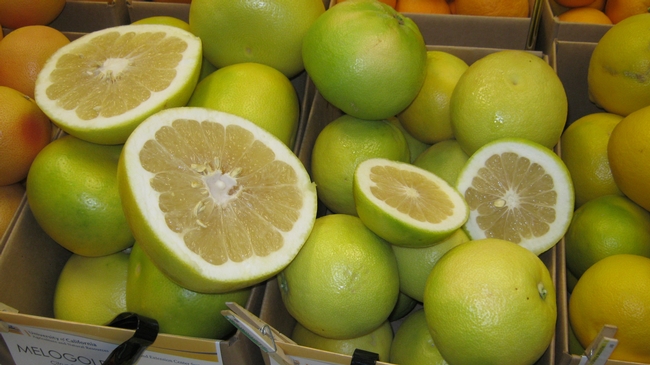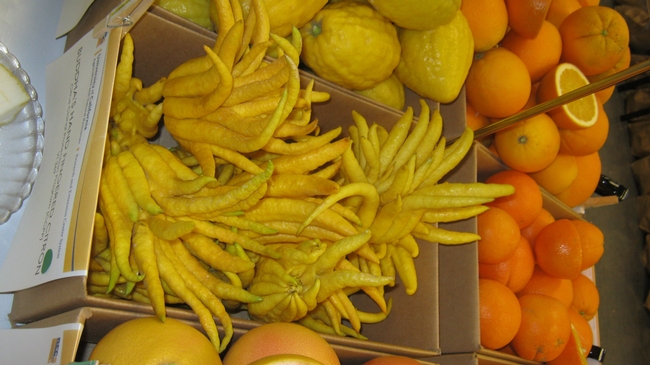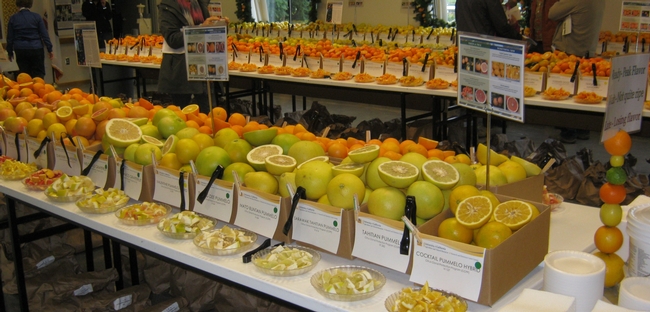- Author: Ben Faber
The recent Huanglongbing Conference in Orlando, FL was chock full of people and ideas. Some of the ideas were still in the fermentation state and some were in practice on farm. One of the ideas that has been put into practice is the use of antibiotics, such as tetracycline and streptomycin to control the bacteria, Candidatus Liberibacter asiaticus (CLas), which causes HLB or citrus greening. This is somewhat disturbing since the rise of antibiotic resistant bacteria which affects humans has been affected by the wide-spread use in animal production facilities. This has led to some food companies to discontinue the sourcing of meat from animals treated with antibiotics for non-health reasons.
Antibiotics are molecules that limit the growth or reproduction of bacteria. They come under the umbrella of bactericides which include antibiotics, but also disinfectants like bleach and copper sulfate and antiseptics like peroxide, iodine and alcohol. Antibiotics when properly used will not harm human tissue and can be derived from bacteria, fungi and synthetically and will often act directly on the bacteria that is causing the disease. Some of these molecules can be simple assemblages of amino acids called peptides (etymology “to digest”) or strings of peptides called proteins. And sometimes they do not work on the bacteria itself, but on steps that lead up to processes that make the bacteria effective at its job.
At the conference, several papers were presented that illustrated this type of antibiotic effect. One of these papers was presented by Robert Shatters for his group. The peptide they are looking at actually inhibits the movement of the CLas bacteria in the gut of the insect, reducing or possibly preventing the transmission of the bacteria to the host plant – citrus.
The following is an abstract from the paper.
Identification of gut epithelium binding peptides that reduce systemic movement of ‘Candidatus' Liberibacter asiaticus within the Asian citrus psyllid vector
Robert G. Shatters, Jr1, Dov Borovsky1, El-Desouky Ammar1, David Hall1, Kasie Sturgeon2, EricaRose Warwick2, Marc Giulianotti3, Radleigh G Santos3 and Clemencia Pinilla4
1USDA, ARS, USHRL, Fort Pierce, FL USA; 2University of Florida, CREC, Lake Alfred, FL USA; 3Torrey Pines Institute for Molecular Studies, Port St Lucie, FL USA; Torrey Pines Institute for Molecular Studies, San Diego, CA USA.
Non-Technical summary: The Asian citrus psyllid is the only known vector of the bacteriumthat causes citrus greening disease. This insect acquires CLas from an infected citrus tree while feeding as a nymph. Transmission to uninfected trees occurs when infected adults emerge and fly off and feed on uninfected trees. Our current understanding of the CLas-psyllid interaction suggests that adults become competent for transmission only after the bacterium moves from the insect gut into the hemolymph and then to the salivary glands. We have identified a set of small peptides that when fed to the psyllid, bind the gut membranes and reduce the ability of the citrus greening bacterium to move from the gut to the salivary glands. These peptides are now being tested to determine if they can be used as an effective way of reducing the spread of citrus greening disease.
This and other paper abstracts will soon be available at: http://irchlb.org/files/33373ab0-7df3-4117-9.pdf
photo: HLB Symptoms
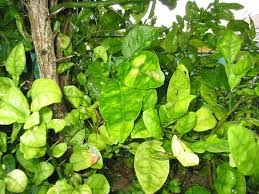
- Author: Godfrey Miles, Ed Stover, Chandrika Ramadugu, Manjunath Keramane and Richard Lee
In a Fort Pierce, FL, field planting, plant growth, and Huanglongbing (HLB)
severity were assessed as indicators of HLB tolerance on progenies of 83 seed-source
accessions of Citrus and Citrus relatives mainly from the Riverside, CA, genebank. The
HLB-associated pathogen [Candidatus Liberibacter asiaticus (CLas)] and vector [asian
citrus psyllid (ACP), Diaphorina citri] were abundant, and trees were naturally
challenged for 6 years before metrics (leaf mottle, percent canopy mottle, overall health,
canopy density, canopy width, canopy height, and trunk diameter) were collected in Oct.
and Nov. 2015. The healthiest trees with low or no HLB symptoms were distant citrus
relatives: Balsamocitrus dawei, Bergera koenigii, Casimiroa edulis, Clausena excavata,
Murraya paniculata, and one accession of Severinia buxifolia. Within Citrus, most of the
healthiest trees with densest canopies, little leaf loss, and greater growth were those with
pedigrees that included Citrus medica (citron). These included progenies of Citrus hybrid
(‘Limon Real'), Citrus limetta, Citrus limettioides, Citrus limonia, C. medica, Citrus
volkameriana, and some Citrus limon accessions. Trees in this category exhibited distinct
leaf-mottle characteristic of HLB and substantial pathogen titers, but maintained dense
canopies and exhibited good growth. Trees from seed-source accessions in the genus
Citrus without citron in their background were generally among the least healthy overall
with less dense canopies. The exceptions were progenies of two Citrus aurantium
accessions, which were markedly healthier than progenies of other Citrus seed-source
accessions not derived from citron. Linear regression analysis, between metrics collected
and pedigree of seed parent, indicated that percentage of citron in the pedigree
significantly correlated with measures of tolerance. Although no commercial Citrus
genotypes yielded progenies with strong HLB resistance, in this field experiment several
progenies maintained dense canopies and good growth, and may be useful for breeding
HLB tolerant cultivars.
HORTSCIENCE 52(1):31–39. 2017. doi: 10.21273/HORTSCI11374-16
Photo: HLB Leaf Symptoms
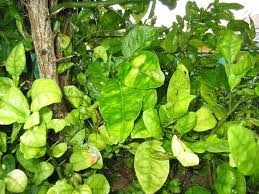
- Author: Ben Faber
Well it came again, the Citrus Tasting at Lindcove Research and Education Center in Lemon Grove near Exeter, close to Visalia and just down the road from Fresno and up from Tulare. They came, growers to see and taste new and old varieties. And then the next day, the general public with oooos and ahhhs to taste the range of flavors we call citrus. Big fruited pummelos and little fruited finger limes. Sweet, sour, not sweet, not sour, dull, and boing!. Growers came on Friday morning and the general public the following Saturday. It was crowded both days.
Citrus is wonderful, everyone knows, but it is also under dire threat of Huanglongbing and the potential destruction of this industry and the trees that are found in many backyards. So in a completely unscientific survey, I asked growers why they were there if their world was about to end. First of all, those who showed up were already optimistic about the future, so there was already a self-selection. But, growers felt like a solution would be found, science would find an answer. Driving across the Valley and through coastal counties like Ventura there are lots of new plantings......if there's water. But it's surprising how confident growers are about finding a solution. There are some hopeful signs out there like the new rootstock release from USDA of US-1516 which shows a lot of tolerance to the disease. Then there is the potential of disease tolerance in a citrus produced in Florida from a collaboration of Southern Gardens, USDA and a consortium of Universities. Yes, there is hope, but years are still needed to test and gear up for production for commercial applications.
So it was good to be around growers who have an enthusiasm for the future and looking for new planting varieites.
And they are both grapefruit, one is Melogold the one on right is Oro Blanco
Buddha's Hand citron
The Citrus Display at Lindcove Research and Extension Center, before the crowds
